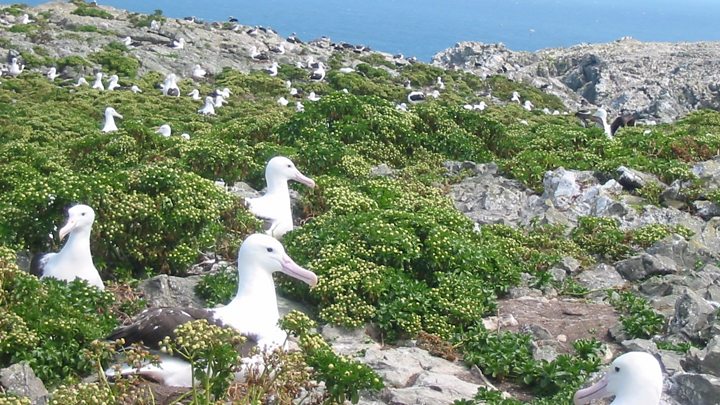Big birds

Scientists have started counting sold birds from space.
They are regulating a highest-resolution satellite images accessible to sign a numbers of Northern Royal albatrosses.
This involved animal nests roughly exclusively on some hilly sea-stacks tighten to New Zealand’s Chatham Islands.
The audit, led by experts during a British Antarctic Survey, represents a initial time any class on Earth has had a whole tellurian race assessed from orbit.
The scientists news a satellite technique in Ibis, a biography of a British Ornithologists’ Union.
Image copyright
DIGITALGLOBE
Craggy outcrop: At initial peek there competence not be most to demeanour at…
It is expected to have a vital impact on efforts to preserve a Northern Royals (Diomedea sanfordi).
Ordinarily, these birds are really formidable to value since their nesting sites are so inaccessible.
Not usually are a sea-stacks distant from NZ (680km), though their straight cliffs meant that any visiting scientist competence also have to be skilful during stone climbing.
Image copyright
PAUL SCOFIELD
“Getting a people, ships or planes to these islands to count a birds is expensive, though it can be really dangerous as well,” explained Dr Peter Fretwell from BAS.
This creates a DigitalGlobe WorldView-3 satellite something of a breakthrough.
It can acquire cinema of Earth that constraint facilities as tiny as 30cm across.
Image copyright
DIGITALGLOBE
…but a some-more we inspect a WorldView-3 images, we start to notice white dots
The US supervision has usually recently accessible such penetrating fortitude to be distributed outward a troops and comprehension sectors.
WorldView-3 can see a nesting birds as they lay on eggs to breed them or as they ensure newly hatched chicks.
With a physique length of over a metre, a adult albatrosses usually uncover adult as dual or 3 pixels, though their white plumage creates them mount out opposite a surrounding vegetation. The BAS organisation literally depends a dots.
Image copyright
Ball Aerospace
WorldView-3 provides a lot of imagery to a US government
The researchers initial checked their methodology during Bird Island, South Georgia.
This is a singular inlet haven in a South Atlantic where a nests of another class of good albatross, a Wandering albatross (Diomedea exulans), are away noted with GPS locators.
The biggest confounding cause is large, light-coloured rocks. But a research showed a organisation could get a really tighten compare between a pixelated birds in a space images and a nests that were accessible in a ground-truth data.
There tends to be a slight over-counting, that a organisation puts down to tact partners or non-breeding birds also being prisoner in a satellite scene.
Applying a technique during a Chatham Islands, a organisation counted usually over 3,600 nests. This is somewhat down on a primer count of 5,700 that was done in 2009.
Dr Fretwell said: “The tact numbers we counted were most reduce than we anticipated, that could uncover us that a race is disappearing or it could uncover usually that we had a quite bad year. But this illustrates since we have to do this over several years, and doing it by satellite is going be a lot cheaper and some-more efficient.”
Image copyright
Google EARTH
The birds foster sea-stacks famous as The Sisters and a Forty Fours
Dr Paul Scofield during Canterbury Museum, NZ, is a co-author on a Ibis paper.
He described a problem of counting a birds in a normal approach during a organisation of stacks famous as a Forty Fours.
“The 44s are quite tricky,” he told BBC News. “I once waited a whole month on a categorical Chatham Island for a continue to transparent so we could land.
“Even if we use a plane, it’s a problem as planes are usually accessible intermittently and a breeze and cloud forestall flying. Then if we take photos, we have to count them. That can take 100s of hours. This record still requires a satellite to be in a right place and no cloud though it is positively cheaper and some-more reliable.”
Image copyright
PAUL SCOFIELD
A Buller’s albatross looks opposite a high cliffs of a Forty Fours
Like a other 5 class of good albatross, Northern Royals are underneath vigour for a accumulation of reasons.
Commercial fishing has depleted a bonds on that these seabirds also feed, and a baited longline rigging used by some vessels has an upsetting knack for attracting foragers and pulling them underwater where they drown.
But a Northern Royals in sold are exposed since of their enterprise to nest usually on a Chatham Islands sea-stacks. If one large charge rolls by during a wrong time of year, it can exceedingly hole tact success.
“In 1986, a outrageous charge cleared waves over these 50m-tall islands,” pronounced Dr Scofield.
Image copyright
PAUL SCOFIELD
Creature of habit: Northern Royal albatrosses nest roughly exclusively around a Chatham Islands
and follow me on Twitter: @BBCAmos
More from my site
Short URL: https://agetimes.net/?p=248201
 Birdwatching from space
Birdwatching from space
 Larsen ice crack continues to open up
Larsen ice crack continues to open up
 Great Dunmow postbox out of action while birds nest inside
Great Dunmow postbox out of action while birds nest inside
 Running ants: Why scientists built an insect treadmill
Running ants: Why scientists built an insect treadmill
 Drone footage shows huge Antarctic ice crack
Drone footage shows huge Antarctic ice crack